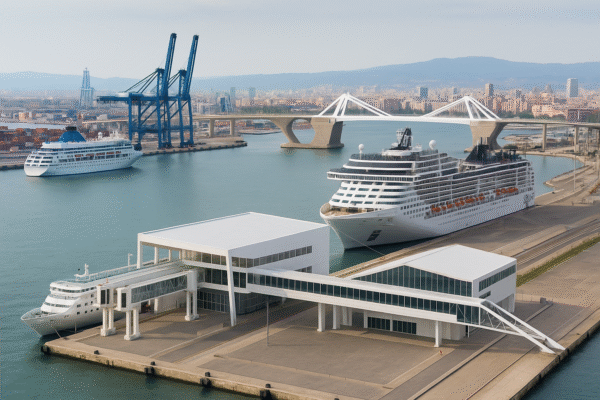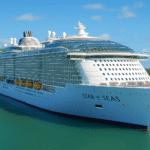Barcelona is setting a new benchmark in sustainable urban tourism as it pushes forward with an ambitious strategy to overhaul its cruise operations. In a decisive move aimed at addressing overtourism, the Port of Barcelona will reduce its cruise terminals from seven to five by 2030, demolishing outdated facilities and constructing modern, eco-conscious alternatives—including a new Terminal C outfitted with shore power capabilities.
Backed by more than €140 million in infrastructure investment, the initiative comes as Barcelona remains Europe’s busiest cruise port, welcoming 1.2 million passengers between January and May 2025 alone—a 20% year-on-year increase. City officials, alarmed by mounting environmental pressures and growing public discontent, are determined to restore balance between tourism growth and urban livability.
A Phased Strategy Rooted in Sustainability
The transformation began in 2018 with a long-term urban development blueprint designed to redirect cruise traffic away from densely populated areas. The closure of the North Terminal in 2023 marked an early milestone. Now, with the latest phase underway, the focus shifts to the demolition of aging terminals, and the creation of next-generation infrastructure.
Terminal C, expected to open in 2028, will serve up to 7,000 passengers and include shore power hookups to eliminate emissions from docked vessels—an industry first for the Mediterranean. This aligns with Spain’s broader sustainability objectives, as the country aims to become a leader in green tourism through low-emission port operations and smart visitor flow management.
Advanced Technology and Smart Mobility
Barcelona is also equipping key tourist zones with real-time crowd monitoring systems to mitigate congestion at popular landmarks such as La Sagrada Família and Park Güell. These digital tools will not only inform visitor decisions but also help local authorities distribute foot traffic evenly across the city, reducing pressure on historic sites.
To support cruise passenger movement without overburdening the city center, Barcelona will launch a fleet of smart electric shuttles linking the port with metro and commuter rail stations. This initiative is part of a wider €90 million upgrade to the Porta d’Europa bridge, improving port access and integrating it with sustainable urban transport networks.
New Cruise Terminal Management Structure
Of the five cruise terminals that will remain operational, four will be managed by private cruise companies—Terminals D and E by Carnival Corporation, Terminal H by MSC Cruises, and the future Terminal G by Royal Caribbean Group. The new Terminal C, however, will remain publicly managed, ensuring the city maintains oversight of its environmental and social impact.
Demolition of the old Terminal C is set to conclude by late 2026, and once construction is completed, Barcelona expects to see a substantial reduction in port-related air and noise pollution, especially near densely populated urban districts.
€50M Quay Revamp to Enhance Visitor Experience
In addition to new terminals, €50 million will be allocated to redevelop the quay area previously occupied by Terminals A and B. This space will be repurposed for cruise operations and feature upgraded guest services, including modern accessibility infrastructure, expanded waiting areas, and renewable energy connections. These improvements aim to elevate the cruise passenger experience while reinforcing Barcelona’s commitment to responsible tourism.
Local Response and Tourism Rebalancing
Residents have long voiced frustration over the burden of mass tourism. Cruise passengers—often in the city for just a few hours—tend to crowd the most iconic spots while contributing minimally to the broader economy. Issues such as inflated housing prices, congested public transport, and rising pollution have led to regular protests and pressure on city officials to act.
According to the Barcelona City Council, these reforms represent an effort to “reclaim the urban space” and ensure tourism does not compromise the well-being of its 1.6 million residents. The initiative also supports the EU’s Green Deal and aligns with Spain’s 2030 Sustainable Tourism Strategy, emphasizing circular economy models and smart destination management.
A Model for Other Mediterranean Cruise Hubs
As cruise traffic continues to surge across Europe, Barcelona’s model of terminal reduction, smart mobility, and crowd management could serve as a blueprint for other Mediterranean cities facing similar challenges—such as Venice, Dubrovnik, and Marseille. The project reflects a growing shift among popular destinations to move beyond sheer tourist volume and toward qualitative, environmentally conscious tourism.
The Ministry of Transport, Mobility and Urban Agenda of Spain has welcomed the move, calling it “a forward-thinking investment in balancing economic opportunity with environmental responsibility.” Spain’s national tourism agency, Turespaña, has also backed the reforms as a pathway to reposition the country as a global leader in sustainable travel experiences.
Conclusion
Barcelona’s cruise tourism reform marks a bold step in reconciling economic growth with ecological and social sustainability. By investing in green infrastructure, limiting port capacity, and embracing smart digital tools, the city is leading a paradigm shift in how global tourism hubs manage cruise traffic. As the rest of Europe grapples with similar issues, Barcelona’s approach may chart the future of cruise tourism in a post-overtourism world.
For more travel news like this, keep reading Global Travel Wire




















